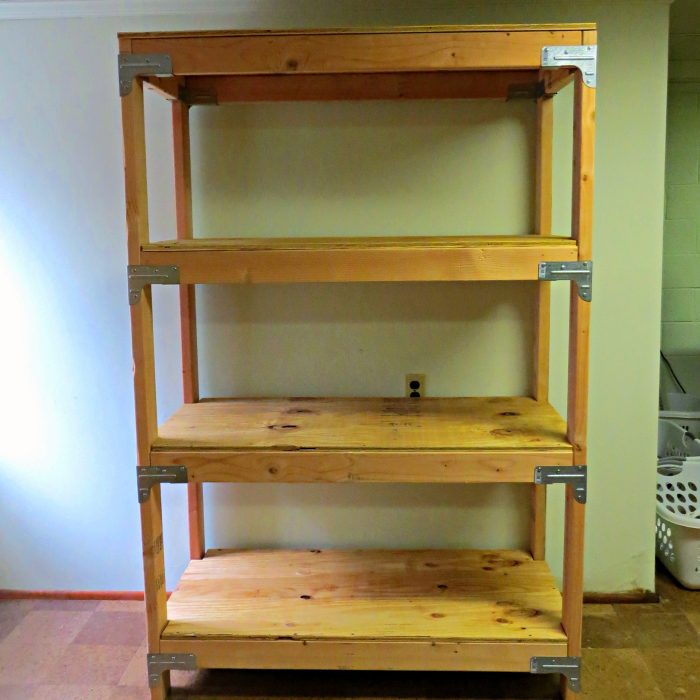DIY shelf unit: Want to add some storage space to your home without breaking the bank? Building your own shelf unit is a rewarding project that allows you to create a custom solution tailored to your needs. From simple designs to intricate creations, the possibilities are endless. This guide will walk you through every step, from choosing materials to adding finishing touches, empowering you to craft a functional and stylish shelf unit.
Whether you’re looking to organize your books, display cherished mementos, or create a dedicated workspace, a DIY shelf unit can be the perfect solution. This comprehensive guide will provide you with the knowledge and skills to embark on this exciting project, helping you create a piece that complements your home and enhances your living space.
DIY Shelf Unit Basics

Building a DIY shelf unit is a rewarding project that allows you to create a custom storage solution for your home or workspace. This guide will walk you through the fundamental components, essential tools and materials, and different types of wood suitable for your project.
Essential Components of a DIY Shelf Unit
A basic DIY shelf unit consists of several key components:
- Shelf Boards: These are the horizontal pieces that form the shelves of the unit. They can be made of various types of wood, depending on your desired look and budget.
- Uprights or Sides: These are the vertical pieces that support the shelf boards and form the sides of the unit. They are usually made of the same type of wood as the shelf boards.
- Braces: These are optional pieces that add stability and strength to the shelf unit, especially for larger units or those with heavy loads. Braces can be horizontal, vertical, or diagonal.
- Shelf Supports: These are small pieces of wood that are attached to the uprights to support the shelf boards. They can be simple brackets, cleats, or more elaborate designs.
- Fasteners: These are used to assemble the various components of the shelf unit. Common fasteners include screws, nails, and wood glue.
Essential Tools and Materials
To build a DIY shelf unit, you will need a few basic tools and materials:
- Measuring Tape: Essential for accurate measurements of your shelf unit.
- Level: Ensures that your shelf unit is level and stable.
- Pencil: For marking cutting lines on the wood.
- Saw: You can use a hand saw, circular saw, or jigsaw to cut the wood. Choose the saw that best suits your skill level and the size of the project.
- Drill: For pre-drilling holes and attaching fasteners.
- Screwdriver: To drive screws into the wood.
- Clamps: To hold the wood pieces together while you secure them with fasteners.
- Wood Glue: For additional strength and stability.
- Sandpaper: To smooth out rough edges and prepare the wood for finishing.
- Wood Finish: Optional, but can be used to protect the wood and enhance its appearance. Choices include paint, stain, or sealant.
Types of Wood for Shelf Units
The type of wood you choose for your DIY shelf unit will depend on your budget, desired look, and the intended use of the unit. Here are some common types of wood used for shelf units, along with their pros and cons:
- Pine: This is a softwood that is relatively inexpensive and easy to work with. However, it is also quite soft and can be prone to scratches and dents.
- Oak: This is a hardwood that is strong and durable, with a beautiful grain pattern. It is also relatively expensive.
- Maple: This is another hardwood that is known for its strength and durability. It has a lighter color than oak and can be stained to achieve various finishes.
- Plywood: This is a manufactured wood product made from layers of veneer glued together. It is strong, stable, and less expensive than solid wood. However, it may not have the same aesthetic appeal as solid wood.
Building a DIY shelf unit is a rewarding experience that allows you to unleash your creativity and personalize your space. By following the steps Artikeld in this guide, you’ll be equipped to construct a sturdy and stylish shelf unit that meets your specific needs. Whether you’re a seasoned DIY enthusiast or a novice builder, this guide will provide you with the necessary information and inspiration to complete this project successfully.
Building a DIY shelf unit can be a rewarding project, allowing you to customize storage solutions for your specific needs. For easy access to items stored in deeper shelves, consider incorporating DIY pull-out shelves. These handy additions make retrieving items effortless and prevent unnecessary strain on your back. With a little creativity and some basic tools, you can create a DIY shelf unit that is both functional and stylish, perfectly tailored to your space.
